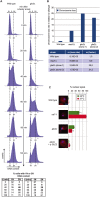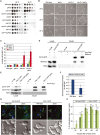Saccharomyces cerevisiae Gle2/Rae1 is involved in septin organization, essential for cell cycle progression
- PMID: 28776765
- PMCID: PMC6472880
- DOI: 10.1002/yea.3249
Saccharomyces cerevisiae Gle2/Rae1 is involved in septin organization, essential for cell cycle progression
Abstract
Gle2/Rae1 is highly conserved from yeast to humans and has been described as an mRNA export factor. Additionally, it is implicated in the anaphase-promoting complex-mediated cell cycle regulation in higher eukaryotes. Here we identify an involvement for Saccharomyces cerevisiae Gle2 in septin organization, which is crucial for cell cycle progression and cell division. Gle2 genetically and physically interacts with components of the septin ring. Importantly, deletion of GLE2 leads to elongated buds, severe defects in septin-assembly and their cellular mislocalization. Septin-ring formation is triggered by the septin-regulating GTPase Cdc42, which establishes and maintains cell polarity. Additionally, activity of the master cell cycle regulator Cdc28 (Cdk1) is needed, which is, besides other functions, also required for G2 /M-transition, and in yeast particularly responsible for initiating the apical-isotropic switch. We show genetic and physical interactions of Gle2 with both Cdc42 and Cdc28. Most importantly, we find that gle2∆ severely mislocalizes Cdc42, leading to defects in septin-complex formation and cell division. Thus, our findings suggest that Gle2 participates in the efficient organization of the septin assembly network, where it might act as a scaffold protein. © 2017 The Authors. Yeast published by John Wiley & Sons, Ltd.
Keywords: Gle2; Rae1; cell cycle regulation; mRNA export; septins.
© 2017 The Authors. Yeast published by John Wiley & Sons, Ltd.
Conflict of interest statement
The authors declare that they have no conflict of interest.
Figures




Similar articles
-
A novel role for the alcohol sensitive ring/PHD finger protein Asr1p in regulating cell cycle mediated by septin-dependent assembly in yeast.Biochem Biophys Res Commun. 2015 Feb 27;458(1):208-13. doi: 10.1016/j.bbrc.2015.01.113. Epub 2015 Jan 31. Biochem Biophys Res Commun. 2015. PMID: 25646695
-
Cell cycle control of septin ring dynamics in the budding yeast.Microbiology (Reading). 2001 Jun;147(Pt 6):1437-1450. doi: 10.1099/00221287-147-6-1437. Microbiology (Reading). 2001. PMID: 11390675
-
The role of Cdc42p GTPase-activating proteins in assembly of the septin ring in yeast.Mol Biol Cell. 2003 Oct;14(10):4051-66. doi: 10.1091/mbc.e03-04-0247. Epub 2003 Jul 25. Mol Biol Cell. 2003. PMID: 14517318 Free PMC article.
-
Architecture, remodeling, and functions of the septin cytoskeleton.Cytoskeleton (Hoboken). 2019 Jan;76(1):7-14. doi: 10.1002/cm.21475. Epub 2018 Aug 2. Cytoskeleton (Hoboken). 2019. PMID: 29979831 Free PMC article. Review.
-
Septin structure and function in yeast and beyond.Trends Cell Biol. 2011 Mar;21(3):141-8. doi: 10.1016/j.tcb.2010.11.006. Epub 2010 Dec 20. Trends Cell Biol. 2011. PMID: 21177106 Free PMC article. Review.
Cited by
-
Optimized fluorescent proteins for 4-color and photoconvertible live-cell imaging in Neurospora crassa.Fungal Genet Biol. 2023 Jan;164:103763. doi: 10.1016/j.fgb.2022.103763. Epub 2022 Dec 5. Fungal Genet Biol. 2023. PMID: 36481248 Free PMC article.
-
Surveillance of 3' mRNA cleavage during transcription termination requires CF IB/Hrp1.Nucleic Acids Res. 2023 Sep 8;51(16):8758-8773. doi: 10.1093/nar/gkad530. Nucleic Acids Res. 2023. PMID: 37351636 Free PMC article.
References
-
- Bharathi A, Ghosh A, Whalen WA, et al 1997. The human Rae1 gene is a functional homologue of Schizosaccharomyces Pombe Rae1 gene involved in nuclear export of poly(A)+ RNA. Gene 198: 251–258. - PubMed
-
- Blevins MB, Smith AM, Phillips EM, Powers MA. 2003. Complex formation among the rna export proteins Nup98, Rae1/Gle2, and Tap. J Biol Chem 278: 20979–20988. - PubMed
MeSH terms
Substances
LinkOut - more resources
Full Text Sources
Other Literature Sources
Molecular Biology Databases
Miscellaneous
